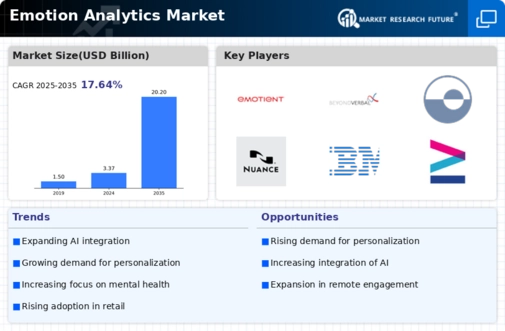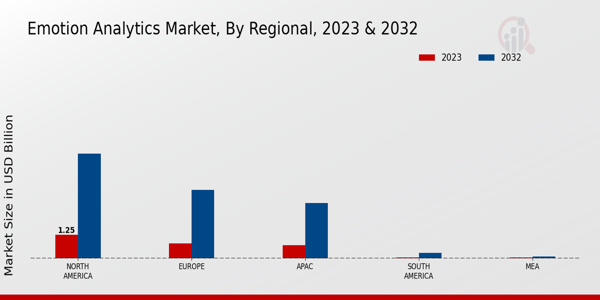Voice Analysis
Facial Expression Recognition
Text Analysis
Psychographic Analysis
On-Premises
Cloud-Based
Retail
Healthcare
Automotive
Media Entertainment
Education
Machine Learning
Deep Learning
Natural Language Processing
North America
Europe
South America
Asia Pacific
Middle East and Africa
North America Outlook (USD Billion, 2019-2032)
North America Emotion Analytics Market by Application Type
Voice Analysis
Facial Expression Recognition
Text Analysis
Psychographic Analysis
North America Emotion Analytics Market by Deployment Type
On-Premises
Cloud-Based
North America Emotion Analytics Market by End Use Type
Retail
Healthcare
Automotive
Media Entertainment
Education
North America Emotion Analytics Market by Technology Type
Machine Learning
Deep Learning
Natural Language Processing
North America Emotion Analytics Market by Regional Type
US
Canada
US Outlook (USD Billion, 2019-2032)
US Emotion Analytics Market by Application Type
Voice Analysis
Facial Expression Recognition
Text Analysis
Psychographic Analysis
US Emotion Analytics Market by Deployment Type
On-Premises
Cloud-Based
US Emotion Analytics Market by End Use Type
Retail
Healthcare
Automotive
Media Entertainment
Education
US Emotion Analytics Market by Technology Type
Machine Learning
Deep Learning
Natural Language Processing
CANADA Outlook (USD Billion, 2019-2032)
CANADA Emotion Analytics Market by Application Type
Voice Analysis
Facial Expression Recognition
Text Analysis
Psychographic Analysis
CANADA Emotion Analytics Market by Deployment Type
On-Premises
Cloud-Based
CANADA Emotion Analytics Market by End Use Type
Retail
Healthcare
Automotive
Media Entertainment
Education
CANADA Emotion Analytics Market by Technology Type
Machine Learning
Deep Learning
Natural Language Processing
Europe Outlook (USD Billion, 2019-2032)
Europe Emotion Analytics Market by Application Type
Voice Analysis
Facial Expression Recognition
Text Analysis
Psychographic Analysis
Europe Emotion Analytics Market by Deployment Type
On-Premises
Cloud-Based
Europe Emotion Analytics Market by End Use Type
Retail
Healthcare
Automotive
Media Entertainment
Education
Europe Emotion Analytics Market by Technology Type
Machine Learning
Deep Learning
Natural Language Processing
Europe Emotion Analytics Market by Regional Type
Germany
UK
France
Russia
Italy
Spain
Rest of Europe
GERMANY Outlook (USD Billion, 2019-2032)
GERMANY Emotion Analytics Market by Application Type
Voice Analysis
Facial Expression Recognition
Text Analysis
Psychographic Analysis
GERMANY Emotion Analytics Market by Deployment Type
On-Premises
Cloud-Based
GERMANY Emotion Analytics Market by End Use Type
Retail
Healthcare
Automotive
Media Entertainment
Education
GERMANY Emotion Analytics Market by Technology Type
Machine Learning
Deep Learning
Natural Language Processing
UK Outlook (USD Billion, 2019-2032)
UK Emotion Analytics Market by Application Type
Voice Analysis
Facial Expression Recognition
Text Analysis
Psychographic Analysis
UK Emotion Analytics Market by Deployment Type
On-Premises
Cloud-Based
UK Emotion Analytics Market by End Use Type
Retail
Healthcare
Automotive
Media Entertainment
Education
UK Emotion Analytics Market by Technology Type
Machine Learning
Deep Learning
Natural Language Processing
FRANCE Outlook (USD Billion, 2019-2032)
FRANCE Emotion Analytics Market by Application Type
Voice Analysis
Facial Expression Recognition
Text Analysis
Psychographic Analysis
FRANCE Emotion Analytics Market by Deployment Type
On-Premises
Cloud-Based
FRANCE Emotion Analytics Market by End Use Type
Retail
Healthcare
Automotive
Media Entertainment
Education
FRANCE Emotion Analytics Market by Technology Type
Machine Learning
Deep Learning
Natural Language Processing
RUSSIA Outlook (USD Billion, 2019-2032)
RUSSIA Emotion Analytics Market by Application Type
Voice Analysis
Facial Expression Recognition
Text Analysis
Psychographic Analysis
RUSSIA Emotion Analytics Market by Deployment Type
On-Premises
Cloud-Based
RUSSIA Emotion Analytics Market by End Use Type
Retail
Healthcare
Automotive
Media Entertainment
Education
RUSSIA Emotion Analytics Market by Technology Type
Machine Learning
Deep Learning
Natural Language Processing
ITALY Outlook (USD Billion, 2019-2032)
ITALY Emotion Analytics Market by Application Type
Voice Analysis
Facial Expression Recognition
Text Analysis
Psychographic Analysis
ITALY Emotion Analytics Market by Deployment Type
On-Premises
Cloud-Based
ITALY Emotion Analytics Market by End Use Type
Retail
Healthcare
Automotive
Media Entertainment
Education
ITALY Emotion Analytics Market by Technology Type
Machine Learning
Deep Learning
Natural Language Processing
SPAIN Outlook (USD Billion, 2019-2032)
SPAIN Emotion Analytics Market by Application Type
Voice Analysis
Facial Expression Recognition
Text Analysis
Psychographic Analysis
SPAIN Emotion Analytics Market by Deployment Type
On-Premises
Cloud-Based
SPAIN Emotion Analytics Market by End Use Type
Retail
Healthcare
Automotive
Media Entertainment
Education
SPAIN Emotion Analytics Market by Technology Type
Machine Learning
Deep Learning
Natural Language Processing
REST OF EUROPE Outlook (USD Billion, 2019-2032)
REST OF EUROPE Emotion Analytics Market by Application Type
Voice Analysis
Facial Expression Recognition
Text Analysis
Psychographic Analysis
REST OF EUROPE Emotion Analytics Market by Deployment Type
On-Premises
Cloud-Based
REST OF EUROPE Emotion Analytics Market by End Use Type
Retail
Healthcare
Automotive
Media Entertainment
Education
REST OF EUROPE Emotion Analytics Market by Technology Type
Machine Learning
Deep Learning
Natural Language Processing
APAC Outlook (USD Billion, 2019-2032)
APAC Emotion Analytics Market by Application Type
Voice Analysis
Facial Expression Recognition
Text Analysis
Psychographic Analysis
APAC Emotion Analytics Market by Deployment Type
On-Premises
Cloud-Based
APAC Emotion Analytics Market by End Use Type
Retail
Healthcare
Automotive
Media Entertainment
Education
APAC Emotion Analytics Market by Technology Type
Machine Learning
Deep Learning
Natural Language Processing
APAC Emotion Analytics Market by Regional Type
China
India
Japan
South Korea
Malaysia
Thailand
Indonesia
Rest of APAC
CHINA Outlook (USD Billion, 2019-2032)
CHINA Emotion Analytics Market by Application Type
Voice Analysis
Facial Expression Recognition
Text Analysis
Psychographic Analysis
CHINA Emotion Analytics Market by Deployment Type
On-Premises
Cloud-Based
CHINA Emotion Analytics Market by End Use Type
Retail
Healthcare
Automotive
Media Entertainment
Education
CHINA Emotion Analytics Market by Technology Type
Machine Learning
Deep Learning
Natural Language Processing
INDIA Outlook (USD Billion, 2019-2032)
INDIA Emotion Analytics Market by Application Type
Voice Analysis
Facial Expression Recognition
Text Analysis
Psychographic Analysis
INDIA Emotion Analytics Market by Deployment Type
On-Premises
Cloud-Based
INDIA Emotion Analytics Market by End Use Type
Retail
Healthcare
Automotive
Media Entertainment
Education
INDIA Emotion Analytics Market by Technology Type
Machine Learning
Deep Learning
Natural Language Processing
JAPAN Outlook (USD Billion, 2019-2032)
JAPAN Emotion Analytics Market by Application Type
Voice Analysis
Facial Expression Recognition
Text Analysis
Psychographic Analysis
JAPAN Emotion Analytics Market by Deployment Type
On-Premises
Cloud-Based
JAPAN Emotion Analytics Market by End Use Type
Retail
Healthcare
Automotive
Media Entertainment
Education
JAPAN Emotion Analytics Market by Technology Type
Machine Learning
Deep Learning
Natural Language Processing
SOUTH KOREA Outlook (USD Billion, 2019-2032)
SOUTH KOREA Emotion Analytics Market by Application Type
Voice Analysis
Facial Expression Recognition
Text Analysis
Psychographic Analysis
SOUTH KOREA Emotion Analytics Market by Deployment Type
On-Premises
Cloud-Based
SOUTH KOREA Emotion Analytics Market by End Use Type
Retail
Healthcare
Automotive
Media Entertainment
Education
SOUTH KOREA Emotion Analytics Market by Technology Type
Machine Learning
Deep Learning
Natural Language Processing
MALAYSIA Outlook (USD Billion, 2019-2032)
MALAYSIA Emotion Analytics Market by Application Type
Voice Analysis
Facial Expression Recognition
Text Analysis
Psychographic Analysis
MALAYSIA Emotion Analytics Market by Deployment Type
On-Premises
Cloud-Based
MALAYSIA Emotion Analytics Market by End Use Type
Retail
Healthcare
Automotive
Media Entertainment
Education
MALAYSIA Emotion Analytics Market by Technology Type
Machine Learning
Deep Learning
Natural Language Processing
THAILAND Outlook (USD Billion, 2019-2032)
THAILAND Emotion Analytics Market by Application Type
Voice Analysis
Facial Expression Recognition
Text Analysis
Psychographic Analysis
THAILAND Emotion Analytics Market by Deployment Type
On-Premises
Cloud-Based
THAILAND Emotion Analytics Market by End Use Type
Retail
Healthcare
Automotive
Media Entertainment
Education
THAILAND Emotion Analytics Market by Technology Type
Machine Learning
Deep Learning
Natural Language Processing
INDONESIA Outlook (USD Billion, 2019-2032)
INDONESIA Emotion Analytics Market by Application Type
Voice Analysis
Facial Expression Recognition
Text Analysis
Psychographic Analysis
INDONESIA Emotion Analytics Market by Deployment Type
On-Premises
Cloud-Based
INDONESIA Emotion Analytics Market by End Use Type
Retail
Healthcare
Automotive
Media Entertainment
Education
INDONESIA Emotion Analytics Market by Technology Type
Machine Learning
Deep Learning
Natural Language Processing
REST OF APAC Outlook (USD Billion, 2019-2032)
REST OF APAC Emotion Analytics Market by Application Type
Voice Analysis
Facial Expression Recognition
Text Analysis
Psychographic Analysis
REST OF APAC Emotion Analytics Market by Deployment Type
On-Premises
Cloud-Based
REST OF APAC Emotion Analytics Market by End Use Type
Retail
Healthcare
Automotive
Media Entertainment
Education
REST OF APAC Emotion Analytics Market by Technology Type
Machine Learning
Deep Learning
Natural Language Processing
South America Outlook (USD Billion, 2019-2032)
South America Emotion Analytics Market by Application Type
Voice Analysis
Facial Expression Recognition
Text Analysis
Psychographic Analysis
South America Emotion Analytics Market by Deployment Type
On-Premises
Cloud-Based
South America Emotion Analytics Market by End Use Type
Retail
Healthcare
Automotive
Media Entertainment
Education
South America Emotion Analytics Market by Technology Type
Machine Learning
Deep Learning
Natural Language Processing
South America Emotion Analytics Market by Regional Type
Brazil
Mexico
Argentina
Rest of South America
BRAZIL Outlook (USD Billion, 2019-2032)
BRAZIL Emotion Analytics Market by Application Type
Voice Analysis
Facial Expression Recognition
Text Analysis
Psychographic Analysis
BRAZIL Emotion Analytics Market by Deployment Type
On-Premises
Cloud-Based
BRAZIL Emotion Analytics Market by End Use Type
Retail
Healthcare
Automotive
Media Entertainment
Education
BRAZIL Emotion Analytics Market by Technology Type
Machine Learning
Deep Learning
Natural Language Processing
MEXICO Outlook (USD Billion, 2019-2032)
MEXICO Emotion Analytics Market by Application Type
Voice Analysis
Facial Expression Recognition
Text Analysis
Psychographic Analysis
MEXICO Emotion Analytics Market by Deployment Type
On-Premises
Cloud-Based
MEXICO Emotion Analytics Market by End Use Type
Retail
Healthcare
Automotive
Media Entertainment
Education
MEXICO Emotion Analytics Market by Technology Type
Machine Learning
Deep Learning
Natural Language Processing
ARGENTINA Outlook (USD Billion, 2019-2032)
ARGENTINA Emotion Analytics Market by Application Type
Voice Analysis
Facial Expression Recognition
Text Analysis
Psychographic Analysis
ARGENTINA Emotion Analytics Market by Deployment Type
On-Premises
Cloud-Based
ARGENTINA Emotion Analytics Market by End Use Type
Retail
Healthcare
Automotive
Media Entertainment
Education
ARGENTINA Emotion Analytics Market by Technology Type
Machine Learning
Deep Learning
Natural Language Processing
REST OF SOUTH AMERICA Outlook (USD Billion, 2019-2032)
REST OF SOUTH AMERICA Emotion Analytics Market by Application Type
Voice Analysis
Facial Expression Recognition
Text Analysis
Psychographic Analysis
REST OF SOUTH AMERICA Emotion Analytics Market by Deployment Type
On-Premises
Cloud-Based
REST OF SOUTH AMERICA Emotion Analytics Market by End Use Type
Retail
Healthcare
Automotive
Media Entertainment
Education
REST OF SOUTH AMERICA Emotion Analytics Market by Technology Type
Machine Learning
Deep Learning
Natural Language Processing
MEA Outlook (USD Billion, 2019-2032)
MEA Emotion Analytics Market by Application Type
Voice Analysis
Facial Expression Recognition
Text Analysis
Psychographic Analysis
MEA Emotion Analytics Market by Deployment Type
On-Premises
Cloud-Based
MEA Emotion Analytics Market by End Use Type
Retail
Healthcare
Automotive
Media Entertainment
Education
MEA Emotion Analytics Market by Technology Type
Machine Learning
Deep Learning
Natural Language Processing
MEA Emotion Analytics Market by Regional Type
GCC Countries
South Africa
Rest of MEA
GCC COUNTRIES Outlook (USD Billion, 2019-2032)
GCC COUNTRIES Emotion Analytics Market by Application Type
Voice Analysis
Facial Expression Recognition
Text Analysis
Psychographic Analysis
GCC COUNTRIES Emotion Analytics Market by Deployment Type
On-Premises
Cloud-Based
GCC COUNTRIES Emotion Analytics Market by End Use Type
Retail
Healthcare
Automotive
Media Entertainment
Education
GCC COUNTRIES Emotion Analytics Market by Technology Type
Machine Learning
Deep Learning
Natural Language Processing
SOUTH AFRICA Outlook (USD Billion, 2019-2032)
SOUTH AFRICA Emotion Analytics Market by Application Type
Voice Analysis
Facial Expression Recognition
Text Analysis
Psychographic Analysis
SOUTH AFRICA Emotion Analytics Market by Deployment Type
On-Premises
Cloud-Based
SOUTH AFRICA Emotion Analytics Market by End Use Type
Retail
Healthcare
Automotive
Media Entertainment
Education
SOUTH AFRICA Emotion Analytics Market by Technology Type
Machine Learning
Deep Learning
Natural Language Processing
REST OF MEA Outlook (USD Billion, 2019-2032)
REST OF MEA Emotion Analytics Market by Application Type
Voice Analysis
Facial Expression Recognition
Text Analysis
Psychographic Analysis
REST OF MEA Emotion Analytics Market by Deployment Type
On-Premises
Cloud-Based
REST OF MEA Emotion Analytics Market by End Use Type
Retail
Healthcare
Automotive
Media Entertainment
Education
REST OF MEA Emotion Analytics Market by Technology Type
Machine Learning
Deep Learning
Natural Language Processing

















Leave a Comment